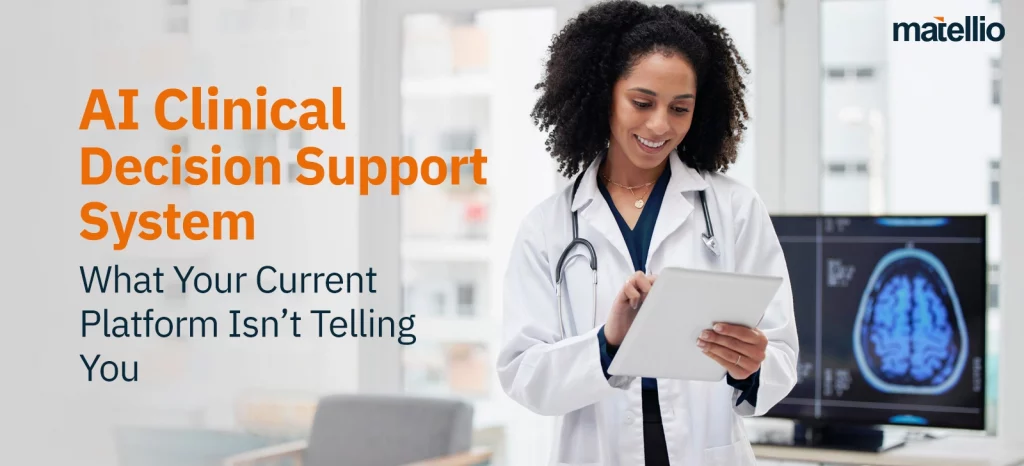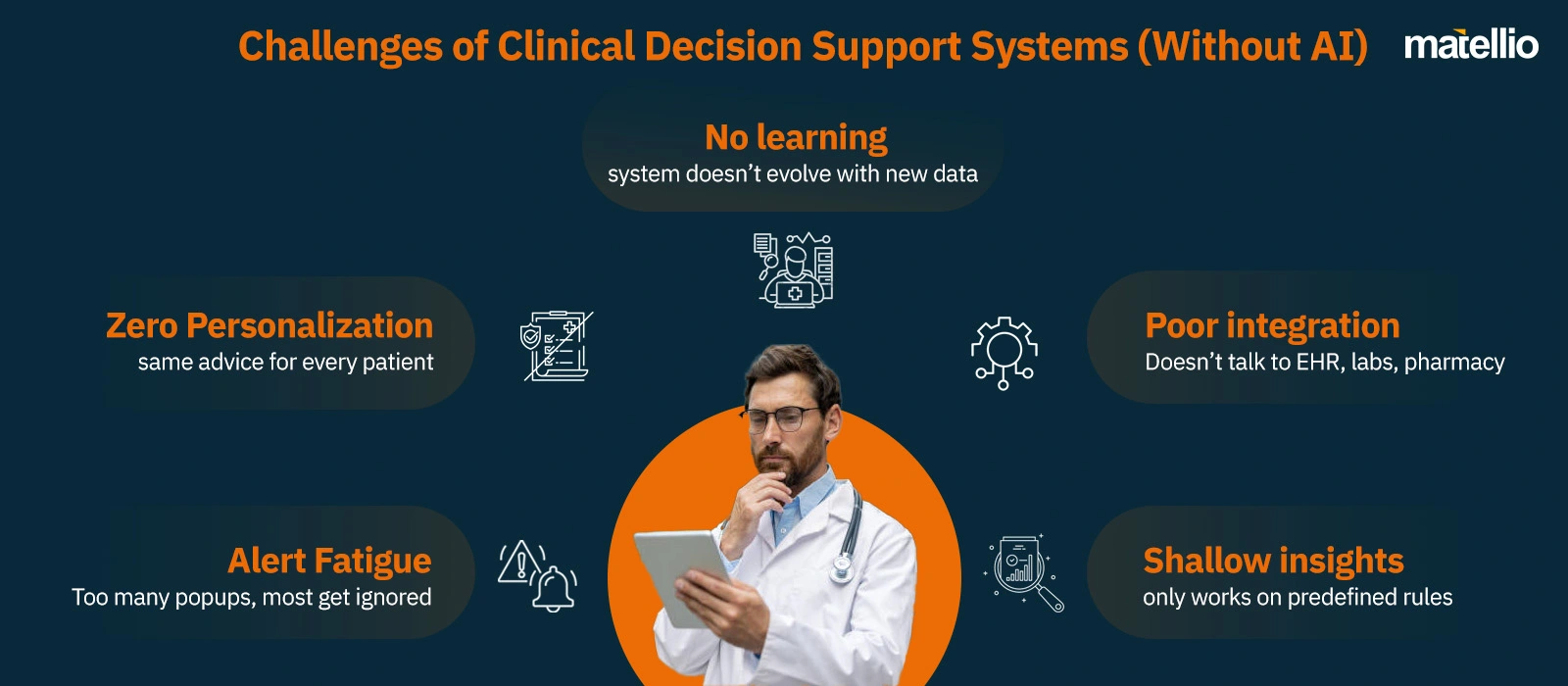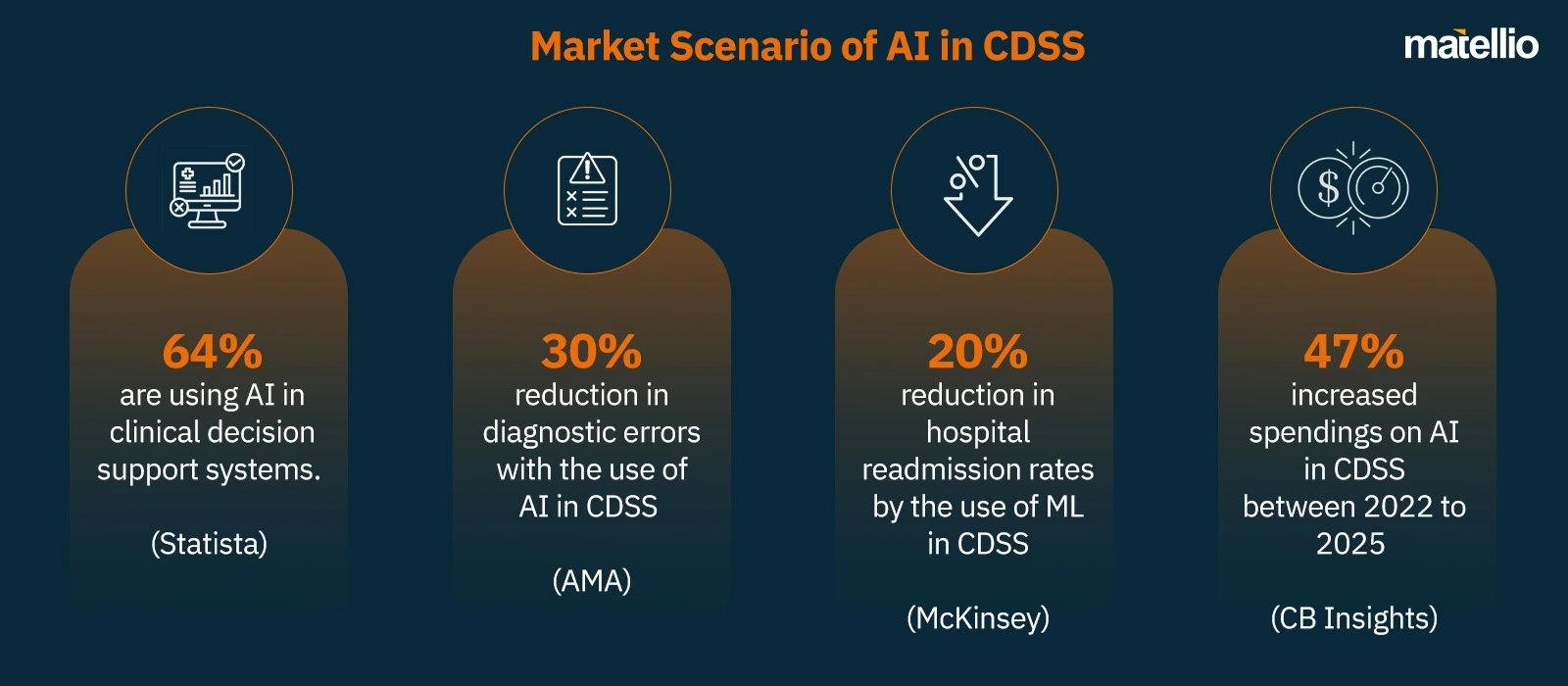
The adoption of clinical decision support systems (CDSS) has been a major thing after the pandemic. But here’s what many healthcare providers haven’t fully unlocked yet: AI clinical decision support systems. Built with real machine learning models and connected to your EHR, an AI-powered clinical decision support system can do a lot more than just flag drug interactions or alert you to allergies.
It learns from your EHR, improves with every patient interaction, and gives your care teams real-time, evidence-based insights. It’s not just rule-based alerts anymore. With machine learning in healthcare, your CDSS can:
- Predict diagnoses based on historical data
- Flag complex drug interactions before they’re missed
- Recommend personalized treatments based on outcomes, not just protocols
- Reduce clinical workload by automating routine decision points
The market is moving fast – CDSS adoption is already climbing toward $2.2 billion by 2027. But the real differentiator? Hospitals investing in AI integration services now are building decision systems that do more than alert. They guide.
Intrigued? Let’s look at what your CDSS should be doing—and how AI can make it happen.
What Is a Clinical Decision Support System – and Why It’s No Longer Enough on Its Own
If you’ve ever asked, “What is a clinical decision support system?”—you’re not alone. Most decision-makers have seen it in action, but many haven’t stopped to think about what it really is—or what it could be.
At its core, a clinical decision support system (CDSS) is software that helps clinicians make safer, faster, and more consistent decisions. It flags drug interactions, checks patient allergies, reminds doctors of screening protocols, and recommends care guidelines based on best practices.
Types of Clinical Decision Support Systems (CDSS)
Understanding the types of clinical decision support systems helps highlight the gap:
- Knowledge-based CDSS: Uses predefined rules (e.g., “If potassium <3.5, alert doctor”)
- Non-knowledge-based CDSS: Leverages machine learning to find patterns and generate insights
- Hybrid systems: Combine both approaches for more flexible logic
Most providers today are still relying on type one. That’s the challenge—and the opportunity.

These are the real challenges of clinical decision support systems—and they’re slowing down care, not speeding it up. That’s why forward-thinking hospitals are moving toward smarter, learning-enabled systems.
Why AI Clinical Decision Support Systems Are Changing the Game
Your clinical team doesn’t need more alerts. They need better ones. That’s where an AI clinical decision support system outperforms traditional CDSS.
It’s not just a rule engine. It’s a system that learns from your hospital’s actual data, gets smarter over time, and fits into your existing EHR workflows without disruption. Here’s what sets ML-powered CDSS apart:
Predictive Intelligence That Goes Beyond Static Rules
A traditional clinical decision support system tells you what’s already been coded into it. But with machine learning in healthcare, your CDSS can predict what’s coming next – based on data from similar cases, patient history, and real-world outcomes.
Instead of “If blood sugar is high, alert,” an ML-based CDSS might say: “This patient is trending toward diabetic ketoacidosis in the next 8 hours—recommend intervention.”
Context-Aware Recommendations, Not One-Size-Fits-All Alerts
With AI, your clinical decision support system software doesn’t just push alerts. It evaluates vitals, labs, comorbidities, medications, and even social determinants of health – then makes contextual suggestions that are actually useful.
For example:
- Suggests a treatment path proven effective for similar patients
- Flags medication issues based on the patient’s renal function
- Recommends follow-ups based on risk profile, not just standard protocols
This is the core advantage of clinical decision support systems powered by AI: it gets specific.
Seamless Integration with EHR and Hospital Systems
Most clinical decision support systems in healthcare struggle to communicate with the EHR, pharmacy system, or lab data feeds. AI-driven platforms, when built by the right healthcare software development company, solve that.
With AI services, we create a smooth data flow between all your core systems – so decisions happen based on real-time data, not yesterday’s reports.
Continuous Learning from Your Own Outcomes
An ML-based CDSS improves as it sees more cases. Over time, it learns what works and what doesn’t—within your own hospital environment. That means smarter alerts, better care plans, and fewer missed opportunities.
This is where ML model development services make a difference. Custom-trained models use your actual patient population, workflows, and outcomes to deliver insights that are specific, not generic.
If you’re investing in a clinical decision support system, it shouldn’t just follow rules—it should learn from experience, evolve with your data, and guide your team in real time. That’s the promise of AI in healthcare. And it’s already delivering results.
Planning to Create an AI-based CDSS? Let’s Get Started with a Free 30-minute Expert Consultation!
Real-World Use Cases of AI Clinical Decision Support Systems
If you’re thinking about investing in a smarter CDSS, here’s what it can actually do in a modern hospital setting. These aren’t ideas. These are real use cases that leading facilities are already putting into practice with measurable results.
| Use Case | Benefit for Hospital |
| Early Diagnosis & Risk Prediction | Prevents deterioration, reduces ICU admissions |
| Smarter Medication Management | Cuts errors, improves safety, boosts compliance |
| Personalized Treatment Pathways | Increases effectiveness, reduces trial-and-error |
| Clinical Documentation Assistance | Saves time, improves billing accuracy |
| Real-Time Imaging Interpretation | Speeds up diagnosis, reduces radiologist fatigue |
| Care Coordination & Discharge Planning | Lowers readmissions, improves care continuity |
Early Diagnosis and Risk Prediction
Let’s say your team is tracking a patient showing mild symptoms. With a standard clinical decision support system, you might not get much beyond a guideline reminder.
But with machine learning in healthcare, your CDSS analyzes lab results, vitals, medication history, and even population-level data—then flags the risk of a critical event, like sepsis or stroke, before it escalates.
How it works:
- Combines lab results, vitals, patient history, and diagnostic images
- Uses predictive models to spot early signs of deterioration
- Flags potential issues before symptoms appear
Hospitals using AI in healthcare are reducing ICU admissions and catching high-risk conditions earlier—and that’s not theoretical. It’s built into smarter workflows.
Smarter Medication Management
Medication errors still cost lives. Your clinical decision support system software should be catching dosing issues, contraindications, and interactions—but most only do surface-level checks.
With an AI clinical decision support system, the platform looks deeper: renal function, lab timing, past reactions, and patient-specific patterns. It doesn’t just tell you “don’t prescribe this.” It tells you why, and what to do instead.
How it works:
- Analyzes EHR data, allergies, current prescriptions
- Checks renal function, labs, and timing of doses
- Suggests alternatives or flags critical concerns
That’s the real advantage of clinical decision support systems powered by AI—they make pharmacists and prescribers sharper, not slower.
Personalized Treatment Pathways
Your clinicians want to do the right thing—but when protocols are one-size-fits-all, they’re often left guessing.
A smart CDSS built with ML model development services uses your own EHR data, past outcomes, and demographics to recommend personalized treatment paths. It doesn’t rely only on published guidelines—it learns from what’s worked in your own hospital.
How it works:
- Uses real treatment outcomes from your facility
- Factors in patient demographics and comorbidities
- Recommends care plans based on predicted response
That’s what separates standard clinical decision support systems in healthcare from the ones that are truly intelligent.
Clinical Documentation Assistance
Let’s be honest: your physicians are probably spending more time on documentation than on care. With automation in healthcare through AI, that changes.
Your AI-enhanced CDSS listens, captures structured insights from provider-patient conversations (via NLP), and suggests entries—ready to review, not rewrite.
How it works:
- Captures spoken insights from doctor-patient interactions
- Extracts structured clinical information using NLP
- Auto-fills billing codes and documentation fields
It syncs with your EHR, billing, and coding systems to reduce manual errors and increase reimbursement accuracy. This is what modern clinical decision support system software should be doing.
Real-Time Imaging Interpretation Support
Imagine your radiologist gets 50 scans to review in one shift. A good AI clinical decision support system doesn’t just sit in the background—it assists.
It highlights anomalies in X-rays, CTs, or MRIs that match historical patterns. It cross-references with EHR data and flags what matters—helping radiologists prioritize urgent cases and reduce false negatives.
How it works:
- Integrates directly with your radiology software
- Analyzes scans using trained AI models
- Flags potential findings before human review
This isn’t future tech. It’s happening right now in U.S. hospitals using AI integration services to enhance imaging workflows.
Care Coordination and Discharge Planning
When it’s time to discharge a patient, your team juggles risk assessments, follow-up scheduling, and home care plans.
With AI clinical decision support systems, you’re not guessing. The system evaluates social factors, clinical progress, and readmission risk to suggest the safest discharge plan—automatically synced with outpatient workflows.
How it works:
- Reviews care progress and patient data
- Assesses readmission risk and home support factors
- Suggests optimal discharge timing and care plan
This improves outcomes, boosts HCAHPS scores, and supports care coordination—while reducing manual work. That’s the kind of upgrade that healthcare software development companies like Matellio are building into smart CDSS platforms today.
Market Overview of AI in Clinical Decision Support Systems
So, you have explored the benefits and the use cases of AI and ML in CDSS. But what about the market scenario? After all, you will be investing a good amount of money and time to implement machine learning in clinical decision support systems! Don’t worry; we have got you covered!
According to Mordor Intelligence, the AI-powered clinical decision support market is projected to grow from $0.87 billion in 2025 to $1.79 billion by 2030! And there is more to it.

These statistics underscore the transformative potential of AI clinical decision support systems in modern healthcare, offering significant benefits in terms of market growth, clinical outcomes, and operational efficiency. So, when are you planning to leverage this golden opportunity for your healthcare facility?
Build Success for Your AI-powered CDSS Development Project with Our Free 30-minute Expert Consultation!
Ready to Get Started? Here’s How Matellio Can Help
If you’re thinking about building or enhancing a clinical decision support system, you don’t just need a software vendor. You need a partner who understands both AI in healthcare and the clinical realities your team faces every day.
That’s exactly where Matellio fits in.
We don’t just plug in AI—we engineer intelligent solutions tailored to your workflows, data, and compliance requirements. Whether you’re starting from scratch or improving your existing system, we bring real-world experience and results-driven strategy to every project.
Here’s how we support your journey to a smarter, more effective AI clinical decision support system:
Real Experience in CDSS Development
We’ve built intelligent platforms that integrate seamlessly with EHRs, lab systems, and diagnostic tools—supporting everything from early diagnosis to medication management.
- Built for clinical decision support systems in healthcare
- Expertise in real-world data modeling, imaging integration, and automated workflows
- Proven results in U.S. healthcare environments
End-to-End AI Integration Services
From strategy and data pipelines to model training and live deployment—we handle the entire stack.
- Complete AI integration services tailored for hospitals and health networks
- Compliance-first development (HIPAA, HL7, FHIR standards)
- Ongoing support, model retraining, and optimization
Custom ML Model Development Services
Need predictive analytics? Risk scoring? Personalized care planning?
- We build custom ML models based on your EHR and claims data
- Full support for machine learning services using hospital-grade datasets
- Your models, your logic—fully explainable and auditable
Built-In Automation for Better Efficiency
Want fewer clicks and more care?
- We integrate RPA services right into your CDSS
- Automate documentation, alerts, care routing, and even discharge plans
- Reduce burnout and boost clinical performance
Whether you’re just exploring the benefits of clinical decision support systems, evaluating existing platforms, or ready to build something transformative—Matellio is the healthcare software development company you can trust to deliver.
Let’s turn your ideas into an intelligent, AI-powered system that actually improves outcomes. Schedule a free 30-minute consultation!


